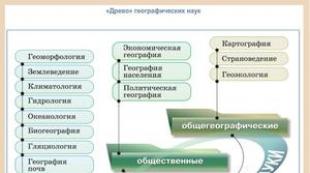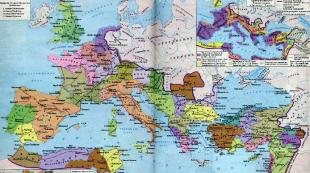In which molecule the bond polarity is higher. Electronegativity. Relative electronegativity. The polarity of a chemical bond, the polarity of molecules and ions. Determination of communication polarity
There are two types of covalent bonds: non-polar and polar... In the case of a non-polar covalent bond, an electron cloud formed by a common pair of electrons, or an electron bond cloud, is distributed in space symmetrically with respect to both atoms. An example is diatomic molecules consisting of atoms of one element: H 2, Cl 2, O 2, N 2, F 2 and others, in which the electron pair equally belongs to both atoms. In the case of a polar covalent bond, the electron cloud of the bond is displaced toward an atom with a higher relative electronegativity. An example is the molecules of volatile inorganic compounds: HCl, H 2 O, H 2 S, NH 3 and others.
Relative electronegativity of atoms
The electric centers of positive and negative charges in the molecule do not coincide at one point, but are located at a certain distance ℓ.
Polar molecule with constant electric dipole moment
A molecule with general neutrality is an electric dipole with a charge q - - at the chlorine atom and q + - at the hydrogen atom. Such bonds and molecules are called polar... The charges of atoms in a molecule q are called effective charges(in the HCl molecule q cl = -0.18; and q n = +0.18 of the absolute electron charge, the degree of ionicity of the bond
A measure of the polarity of a bond and a molecule is electric moment of a dipole(μ - "mu") is determined by the product
μ = qℓ, Kl ∙ m or μ = qℓ / 3.33 ∙ 10 -30, D
where q is the effective charge; ℓ is the length of the dipole. The unit of the electric moment of the dipole (SI system) is expressed as 3.33 ∙ 10 -30 C ∙ m (coulomb meter) = 1D (D - Debye).
The electric moment of a dipole is a vector quantity. Its direction is conventionally taken from a positive charge to a negative one - towards the displacement of the bonding electron cloud. The greater the difference in the electronegativities of the elements in polar molecules, the greater the electric moment of the dipole.
For polyatomic molecules, one should distinguish between the concepts of the dipole moments of individual bonds and the molecule as a whole. Since, in the presence of several bonds in a molecule, their dipole moments are added according to the parallelogram rule, then depending on the shape of the molecule, determined by the direction of the bonds, the resulting dipole moment differs from the dipole moments of individual bonds and in the particular case (for highly symmetric molecules) can be equal to zero, despite on the significant polarity of individual bonds. For example, a linear CO 2 molecule is non-polar (μ = 0), although each C = O bond has a significant dipole moment (μ = 2.7 D).
2.7 D 2.7 d
Molecules containing a non-polar covalent bond are called non-polar or homeopolar... In such molecules, the bonding electron cloud is distributed symmetrically between the nuclei of both atoms, and the nuclei act on it equally. An example is the molecules of simple substances, consisting of atoms of one element: H 2, Cl 2, O 2, N 2, F 2 and others. The electric moment of the dipole of such molecules is zero.
The ability of molecules (and individual bonds) to polarize under the influence of an external electric field is called polarizability. This can also occur under the influence of the field created by the approaching polar molecule. Therefore, polarizability is of great importance in chemical reactions.
It is always important to consider the polarity of the molecule and its electrical dipole moment. The latter is associated with the reactivity of substances. As a rule, the greater the electric moment of the dipole of the molecule, the higher the reactivity of the substance. The solubility of substances is also associated with the electric moment of the dipole. Polar molecules of liquids favor the electrical dissociation of the electrolytes dissolved in them according to the principle “like dissolves in like”.
In homonuclear molecules (H 2, F 2, etc.), the electron pair forming a bond equally belongs to each atom, therefore the centers of positive and negative charges in the molecule coincide. Such molecules are non-polar.
However, in heteronuclear molecules, the contribution to the coupling of the wave functions of different atoms is not the same. An excess electron density appears near one of the atoms, therefore, an excess negative charge, and near the other, a positive one. In this case, they talk about the displacement of an electron pair from one atom to another, but this should not be understood literally, but only as an increase in the probability of finding an electron pair near one of the nuclei of the molecule.
To determine the direction of such a displacement and a semi-quantitative estimate of its magnitude, the concept of electronegativity was introduced.
There are several scales of electronegativity. However, the elements are arranged in a row in terms of electronegativity in the same order, therefore the differences are insignificant, and the electronegativity scales are quite comparable.
R. Mulliken's electronegativity is the half-sum of ionization energies and electron affinity (see Section 2.10.3):
The valence electron pair is shifted to a more electronegative atom.
It is more convenient to use not absolute values of electronegativity, but relative ones. The electronegativity of lithium 3 Li is taken as unity. The relative electronegativity of any element A is equal to:
Heavy alkali metals have the lowest electronegativity (X Fr = 0.7). The most electronegative element is fluorine (X F = 4.0). By periods, there is a general tendency towards an increase in electronegativity, and by subgroups - its decrease (Table 3.4).
In the practical use of the data of this table (as well as the data of other electronegativity scales), it should be borne in mind that in molecules consisting of three or more atoms, the value of electronegativity can change markedly under the influence of neighboring atoms. Strictly speaking, a constant electronegativity cannot be ascribed to an element at all. It depends on the valence state of the element, the type of compound, etc. Nevertheless, this concept is useful for a qualitative explanation of the properties of chemical bonds and compounds.
Table 3.4
Pauling electronegativity of s- and p-elements
|
Period |
Group |
||||||
The polarity of the bond is determined by the displacement of the valence electron pair in diatomic molecules and is quantitatively characterized dipole moment, or electric moment of the dipole, molecules. It is equal to the product of the distance between the nuclei G in a molecule and an effective charge 5 corresponding to this distance:
Insofar as G considered a vector directed from positive to negative charge, the dipole moment is also a vector and has the same direction. The unit of measurement of the dipole moment is the D-debye (1D = 3.33 10 -30 C m).
The dipole moment of a complex molecule is defined as the vector sum of the dipole moments of all bonds. Therefore, if the AB I molecule is symmetric with respect to the line of each bond, the total dipole moment of such a molecule, despite the polar
the number of bonds A-B is equal to zero: D = ^ D; = 0. Examples are the cases
the previously considered symmetric molecules, the bonds in which are formed by hybrid orbitals: BeF 2, BF 3, CH 4, SF 6, etc.
Molecules in which bonds are formed by non-hybrid orbitals or hybrid orbitals with the participation of lone pairs of electrons are asymmetric with respect to the bond lines. The dipole moments of such molecules are not equal to zero. Examples of such polar molecules: H 2 S, NH 3, H 2 0, etc. In fig. 3.18 shows a graphical interpretation of the summation of the vectors of polar bonds in a symmetric molecule BeF 2 (fl) and an asymmetric molecule H 2 S (b).

Rice. 3.18. Dipole moments of (a) BeF 2 and (b) H 2 S molecules
As already noted, the greater the difference between the electronegativities of the atoms forming the bond, the more the valence electron pair is displaced, the more polar the bond and, therefore, the greater the effective charge b, which is illustrated in Table. 3.5.
Table 3.5
Changes in the nature of the bond in a series of compounds of period II elements with fluorine
In the polar bond, two components can be conventionally distinguished: ionic, due to electrostatic attraction, and covalent, due to overlapping of orbitals. As the difference of electronegativities increases OH the valence electron pair is increasingly displaced towards the fluorine atom, which acquires an increasingly negative effective charge. The contribution of the ionic component to the bond increases, the fraction of the covalent component decreases. Quantitative changes turn into qualitative ones: in the UF molecule, the electron pair belongs almost entirely to fluorine, and its effective charge approaches unity, i.e. to the electron charge. We can assume that two ions have formed: the Li + cation and the anion F ~, and the bond is due only to their electrostatic attraction (the covalent component can be neglected). This connection is called ionic. It can be seen as an extreme case of a covalent polar bond.
The electrostatic field has no preferred directions. That's why ionic bond unlike covalent directionality is not peculiar. An ion interacts with any number of ions of the opposite charge. This is due to another distinctive property of the ionic bond - lack of saturation.
For ionic molecules, the binding energy can be calculated. If we consider ions as non-deformable balls with charges ± e, then the force of attraction between them, depending on the distance between the centers of the ions G can be expressed by the Coulomb equation:
The energy of attraction is determined by the ratio 
When approaching, a repulsive force appears due to the interaction of electron shells. It is inversely proportional to the distance to the degree NS:
where V- some constant. Exponent NS much more than unity and for various configurations of ions lies in the range from 5 to 12. Taking into account that the force is the derivative of energy with respect to distance, from equation (3.6) we obtain:

With change G change F np and F qtt. At some distance r 0 these forces are equalized, which corresponds to the minimum of the resulting interaction energy U Q. After transformations, you can get
This equation is known as the Born equation.
The minimum on the dependence curve U = f (r) the equilibrium distance r 0 and the energy U Q. This is the binding energy between ions. Even NS is unknown, then we can estimate the value of the binding energy, taking 1 /NS equal to zero:

In this case, the error will not exceed 20%.
For ions with charges z l and z 2 equations (3.7) and (3.8) take the form:

Since in molecules of this type the existence of a bond approaching a purely ionic one is problematic, the last equations should be considered a very rough approximation.
At the same time, the problems of bond polarity and ionicity can be approached from the opposite position - from the point of view of ion polarization. It is assumed that there is a complete transfer of electrons, and the molecule consists of isolated ions. Then, the electron clouds are displaced under the influence of the electric field created by the ions - polarization ions.
Polarization is a two-pronged process that combines polarizing action ions from their polarizability. Polarizability is the ability of an electron cloud of an ion, molecule or atom to deform under the influence of the electrostatic field of another ion. The strength of this field determines the polarizing effect of the ion. From equation (3.10) it follows that the polarizing action of the ion is the greater, the greater its charge and the smaller the radius. The radii of the cations, as a rule, are much smaller than the radii of the anions; therefore, in practice, one has to deal more often with the polarization of anions under the action of cations, and not vice versa. The polarizability of ions also depends on their charge and radius. Ions of large size and charge are more easily polarized. The polarizing action of an ion is reduced to pulling on itself an electron cloud of an ion of the opposite charge. As a result, the ionicity of the bond decreases, i.e. the bond becomes polar covalent. Thus, the polarization of ions reduces the degree of ionicity of the bond and, in its effect, is opposite to the polarization of the bond.
Polarization of ions in a molecule, i.e. an increase in the proportion of covalent bonds in it, increases the strength of its decay into ions. In the series of compounds of a given cation with anions of the same type, the degree of dissociation in solutions decreases with an increase in the polarizability of the anions. For example, in the series of lead halides PbCl 2 - PbBr 2 - PN 2, the radius of halide anions increases, their polarizability increases, and decomposition into ions decreases, which is reflected in a decrease in solubility.
When comparing the properties of salts with the same anion and sufficiently large cations, the polarization of the cations should be taken into account. For example, the radius of the Hg 2+ ion is greater than the radius of the Ca 2+ ion, so Hg 2+ is more polarized than Ca 2+. As a result, CaCl 2 is a strong electrolyte, i.e. dissociates completely in solution, and HgCl 2 - with a weak electrolyte, i.e. practically does not dissociate in solutions.
The polarization of ions in a molecule reduces its strength when decaying into atoms or molecules. For example, in the series CaCl 2 - CaBr 2 - Ca1 2, the radius of halide ions increases, their polarization by the Ca 2+ ion increases, therefore the temperature of thermal dissociation into calcium and halogen decreases: CaHa1 2 = Ca + Ha1 2.
If an ion is easily polarized, then a small energy is required to excite it, which corresponds to the absorption of quanta of visible light. This is the reason for the color of solutions of such compounds. An increase in polarizability leads to an increase in color, for example, in the series NiCl 2 - NiBr 2 - Nil 2 (increased polarizability of the anion) or in the series KC1 - CuCl 2 (increased polarizability of the cation).
The boundary between the covalent polar and ionic bonds is rather arbitrary. For molecules in a gaseous state, it is believed that with the difference of electronegativities AH> 2.5 the bond is ionic. In solutions of polar solvents, as well as in the crystalline state, the solvent molecules and neighboring particles at the sites of the crystal lattice have a strong effect, respectively. Therefore, the ionic nature of the bond manifests itself at a much smaller difference in electronegativity. In practice, we can assume that the relationship between typical metals and non-metals in solutions and crystals is ionic.
A molecule is polar if the center of the negative charge does not coincide with the center of the positive one. Such a molecule is a dipole: two charges of equal magnitude and opposite in sign are separated in space.
A dipole is usually denoted by a symbol where the arrow points from the positive end of the dipole to the negative end. The molecule has a dipole moment, which is equal to the magnitude of the charge multiplied by the distance between the centers of the charges:
![]()
The dipole moments of molecules can be measured; some of the values found are given in table. 1.2. The values of the dipole moments serve as a measure of the relative polarity of various molecules.
Table 1.2 (see scan) Dipole moments
Undoubtedly, a molecule is polar, if only the bonds in it are polar. We will consider the polarity of a bond because the polarity of a molecule can be thought of as the sum of the polarities of individual bonds.
Molecules such as have a dipole moment equal to zero, that is, they are non-polar. Two identical atoms in any of the given molecules have, of course, the same electronegativity and equally own electrons; the charge is zero and, therefore, the dipole moment is also zero.
A type molecule has a large dipole moment Although the hydrogen fluoride molecule is small, electronegative fluorine strongly attracts electrons; although the distance is small, the charge is large, and hence the dipole moment is also large.
Methane and carbon tetrachloride have zero dipole moments. Individual bonds, at least in carbon tetrachloride, are polar: however, due to the symmetry of the tetrahedral arrangement, they cancel each other out (Fig. 1.9). In methyl chloride, the polarity of the carbon - chlorine bond is not compensated and the dipole moment of methyl chloride is thus, the polarity of molecules depends not only on the polarity of individual bonds, but also on their direction, i.e., on the shape of the molecule.
The dipole moment of ammonia is equal to It can be considered as the total dipole moment (vector sum) of three moments of individual bonds having the direction shown in the figure.

Rice. 1.9. Dipole moments of some molecules. The polarity of bonds and molecules.
The dipole moment of water, equal to

What dipole moment should be expected for nitrogen trifluoride, which, like ammonia, has a pyramidal structure? Fluorine is the most electronegative element, and it certainly pulls electrons away from nitrogen a lot; therefore, the nitrogen - fluorine bonds must be strongly polar and their vector sum must be large - much more than for ammonia with its not very polar bonds.

What does the experiment give? The dipole moment of nitrogen trifluoride is only equal to It is significantly less than the dipole moment of ammonia.
How can this fact be explained? The above discussion did not take into account the lone pair of electrons. B (as in this pair it occupies the -orbital and its contribution to the dipole moment should have the opposite direction compared to the total moment of the nitrogen - fluorine bonds (Fig. 1.10); these moments of the opposite sign, obviously, have approximately the same value, and as a result, a small dipole moment is observed, the direction of which is unknown.In ammonia, the dipole moment is probably determined mainly by this free electron pair, and it is increased due to the sum of the bond moments. of course, any other molecules in which they are present.
From the values of the dipole moments, valuable information about the structure of molecules can be obtained. For example, you can exclude any structure of carbon tetrachloride leading to a polar molecule, only “on the basis of the magnitude of the dipole moment.

Rice. 1.10. Dipole moments of some molecules. Contribution of the lone pair of electrons. The dipole moment due to the lone pair of electrons has a direction opposite to the direction of the total vector of bond moments.
Thus, the dipole moment confirms the tetrahedral structure of carbon tetrachloride (although it does not, since other structures are possible, which will also give a non-polar molecule).
Task 1.4. Which of the two possible structures below should also have a zero dipole moment? a) Carbon is located in the center of the square, at the corners of which are chlorine atoms, b) Carbon is located at the top of the tetrahedral pyramid, and chlorine atoms are in the corners of the base.
Task 1.5. Although the carbon - oxygen and boron - fluorine bonds must be polar, the dipole moment of the compounds is zero. Suggest the arrangement of atoms for each compound that would result in a zero dipole moment.
For most compounds, the dipole moment has never been measured. The polarity of these compounds can be predicted from their structure. The polarity of bonds is determined by the electronegativity of the atoms; if the angles between the bonds are known, then the polarity of the molecule can be determined, taking into account also the unpaired pairs of electrons.

Electronegativity of atoms of elements. Relative electronegativity. Change in periods and groups of the Periodic Table. The polarity of a chemical bond, the polarity of molecules and ions.
Electronegativity (EO) is the ability of an atom to displace electron pairs towards itself.
The measure of e.o. is the energy equal arithmetically to ½ the sum of the ionization energy I and the energy of similarity to the electron E
E.O. = ½ (I + E)
Relative electronegativity. (OEE)
Fluorine, as the strongest e.o element, is assigned a value of 4.00 relative to which the remaining elements are considered.
Changes in periods and groups of the Periodic Table.
Inside the periods, with an increase in the nuclear charge from left to right, electronegativity increases.
Least the value is observed in alkali and alkaline earth metals.
The greatest- for halogens.
The higher the electronegativity, the stronger the non-metallic properties of the elements are.
Electronegativity (χ) is fundamental chemical property atom, a quantitative characteristic of the ability of an atom in a molecule to displace common electron pairs towards itself.
The modern concept of the electronegativity of atoms was introduced by the American chemist L. Pauling. L. Pauling used the concept of electronegativity to explain the fact that the energy of a heteroatomic links A-B(A, B are symbols of any chemical elements) in the general case is greater than the geometric mean of the homoatomic links A-A and B-B.
The highest value of e.o. fluorine, and the lowest is cesium.
The theoretical definition of electronegativity was proposed by the American physicist R. Mulliken. Proceeding from the obvious proposition that the ability of an atom in a molecule to attract an electron charge to itself depends on the ionization energy of an atom and its affinity for an electron, R. Mulliken introduced the concept of the electronegativity of an atom A as the average value of the binding energy of outer electrons during the ionization of valence states ( for example, from A− to A +) and on this basis proposed a very simple relation for the electronegativity of an atom:
where J1A and εA are the ionization energy of the atom and its electron affinity, respectively.
Strictly speaking, constant electronegativity cannot be ascribed to an element. The electronegativity of an atom depends on many factors, in particular, on the valence state of the atom, the formal oxidation state, the coordination number, the nature of the ligands that make up the environment of the atom in the molecular system, and some others. Recently, the so-called orbital electronegativity has been used more and more often to characterize electronegativity, which depends on the type of atomic orbital involved in the formation of a bond and on its electron population, i.e., on whether the atomic orbital is occupied by a lone electron pair, is populated once by an unpaired electron, or is vacant. But, despite the well-known difficulties in the interpretation and definition of electronegativity, it always remains necessary for the qualitative description and prediction of the nature of bonds in a molecular system, including the binding energy, the distribution of the electron charge and the degree of ionicity, the force constant, etc. the current approach is the Sanderson approach. This approach is based on the idea of aligning the electronegativities of atoms during the formation of a chemical bond between them. In numerous studies, relationships have been found between Sanderson's electronegativities and the most important physicochemical properties of inorganic compounds of the vast majority of elements of the periodic table. The modification of Sanderson's method, based on the redistribution of electronegativity between the atoms of the molecule for organic compounds, turned out to be very fruitful.
2) The polarity of the chemical bond, the polarity of molecules and ions.
What is in the synopsis and in the textbook-Polarity is associated with the dipole moment. It manifests itself as a result of the displacement of a common electron pair to one of the atoms. Polarity also depends on the difference in electronegativity of the atoms bonded. The higher the value of the e.o. two atoms, the more polar is the chemical bond between them. Depending on how the redistribution of the electron density during the formation of a chemical bond, there are several types of it. The limiting case of chemical bond polarization is a complete transition from one atom to another.
In this case, two ions are formed, between which an ionic bond arises. In order for two atoms to be able to create an ionic bond, it is necessary that their e.o. very differently. If e.o. are equal, then a non-polar covalent bond is formed. Most often, a polar covalent bond is found - it is formed between any atoms with different e.o. values.
The effective charges of atoms can serve as a quantitative estimate of the polarity of a bond. The effective charge of an atom characterizes the difference between the number of electrons belonging to a given atom in a chemical compound and the number of electrons of a free atom. An atom of a more electronegative element attracts electrons more strongly, so electrons are closer to it, and it receives some negative charge, which is called effective, and its partner has the same positive effective charge. If the electrons forming a bond between the atoms belong to them equally, the effective charges are equal to zero.
For diatomic molecules, the polarity of the bond can be characterized and the effective charges of atoms can be determined by measuring the dipole moment M = q * r where q is the charge of the dipole pole, equal to the effective charge for a diatomic molecule, r is the internuclear distance. The dipole moment of the bond is a vector quantity. It is directed from the positively charged part of the molecule to its negative part. The effective charge on the atom of the element does not coincide with the oxidation state.
The polarity of molecules largely determines the properties of substances. Polar molecules turn to each other with oppositely charged poles, and mutual attraction arises between them. Therefore, substances formed by polar molecules have higher melting and boiling points than substances whose molecules are non-polar.
Liquids with polar molecules have a higher dissolving power. Moreover, the greater the polarity of the solvent molecules, the higher the solubility of polar or ionic compounds in it. This dependence is explained by the fact that the polar molecules of the solvent, due to the dipole-dipole or ion-dipole interaction with the solute, contribute to the decomposition of the solute into ions. For example, a solution of hydrogen chloride in water, the molecules of which are polar, conducts electric current well. A solution of hydrogen chloride in benzene has no appreciable electrical conductivity. This indicates the absence of hydrogen chloride ionization in the benzene solution, since benzene molecules are non-polar.
Ions, like an electric field, have a polarizing effect on each other. When two ions meet, their mutual polarization occurs, i.e. displacement of the electrons of the outer layers relative to the nuclei. The mutual polarization of ions depends on the charges of the nucleus and the ion, the radius of the ion, and other factors.
Within the groups of e.o. decreases.
The metallic properties of the elements increase.
Metallic elements at the external energy level contain 1,2,3 electrons and are characterized by a low value of ionization potentials and e.o. because metals show a pronounced tendency to give up electrons.
Non-metallic elements have a higher ionization energy.
As the outer shell is filled, the atomic radius of non-metals within the periods decreases. The number of electrons on the outer shell is equal to 4,5,6,7,8.
The polarity of the chemical bond. Polarity of molecules and ions.
The polarity of the chemical bond is determined by the displacement of the bonds of an electron pair to one of the atoms.
The chemical bond arises due to the redistribution of electrons of the valence orbitals, as a result of which a stable electronic configuration of a noble gas arises, due to the formation of ions or the formation of common electron pairs.
The chemical bond is characterized by energy and length.
The measure of bond strength is the energy expended to break the bond.
For example. H - H = 435 kJmol-1
Electronegativity of atomic elements
Electronegativity is a chemical property of an atom, a quantitative characteristic of the ability of an atom in a molecule to attract electrons to itself from atoms of other elements.
Relative electronegativity
The first and most famous scale of relative electronegativity is L. Pauling's scale, obtained from thermochemical data and proposed in 1932. The electronegativity value of the most electronegative element fluorine, (F) = 4.0, is arbitrarily taken as the starting point in this scale.
Elements of group VIII periodic system(noble gases) have zero electronegativity;
The conditional boundary between metals and non-metals is the value of relative electronegativity equal to 2.
The electronegativity of the elements of the periodic table, as a rule, sequentially increases from left to right in each period. Within each group, with a few exceptions, electronegativity gradually decreases from top to bottom. Electronegativities can be used to characterize a chemical bond.
Bonds with a smaller difference in the electronegativities of atoms are referred to as polar covalent bonds. The smaller the difference in the electronegativities of the atoms forming a chemical bond, the lower the degree of ionicity of this bond. A zero difference in the electronegativities of atoms indicates the absence of an ionic character in the bond formed by them, that is, its highly covalent.
Chemical bond polarity, molecule and ion polarity
The polarity of chemical bonds, a characteristic of a chemical bond, showing the redistribution of electron density in space near nuclei in comparison with the initial distribution of this density in neutral atoms forming this bond.
Almost all chemical bonds, with the exception of bonds in diatomic homonuclear molecules, are polar to one degree or another. Usually, covalent bonds are weakly polar, ionic bonds are highly polar.
For example:
covalent non-polar: Cl2, O2, N2, H2, Br2
covalent polar: H2O, SO2, HCl, NH3, etc.
Polarity.
Depending on the location of the common electron pair (electron density) between the nuclei of atoms, non-polar and polar bonds are distinguished.
A non-polar bond is formed by atoms of elements with the same electronegativity. The electron density is distributed symmetrically with respect to the nuclei of atoms.
The bond between atoms with different electronegativity is called polar. The total electron pair is biased towards the more electronegative element. The centers of gravity of positive (b +) and negative (b -) charges do not coincide. The greater the difference in electronegativity of the elements forming the bond, the higher the polarity of the bond. When the difference in electronegativity is less than 1.9, the bond is considered polar covalent.
For a diatomic molecule, the polarity of the molecule coincides with the polarity of the bond. In polyatomic molecules, the total dipole moment of a molecule is equal to the vector sum of the moments of all its bonds. The dipole vector is directed from + to -
Example 3. Using the valence bond method, determine the polarity of the tin (II) chloride and tin (IV) chloride molecules.
50 Sn refers to p - elements.
Valence electrons 5s 2 5p 2. Distribution of electrons over quantum cells in the normal state:
| |
| |
| |
Chemical formulas of tin (IV) chloride -SnCl 4, tin (II) chloride - SnCl 2
To construct the geometric shape of the molecules, we will depict the orbitals of unpaired valence electrons, taking into account their maximum overlap
Rice. 4. Geometric shape of SnCl 2 and SnCl 4 molecules
The electronegativity of Sn is 1.8. Cl - 3.0. Sn - Cl bond, polar, covalent. Let us represent the vectors of the dipole moments of the polar bonds.
in molecules SnCl 2 and SnCl 4
SnCl 2 - polar molecule
SnCl 4 is a non-polar molecule.
Substances, depending on temperature and pressure, can exist in a gaseous, liquid and solid state of aggregation.
In a gaseous state, substances are in the form of individual molecules.
In the liquid state in the form of aggregates, where the molecules are bound by intermolecular van der Waals forces or hydrogen bonds. Moreover, the more polar the molecules, the stronger the bond and, as a result, the higher the boiling point of the liquid.
In solids, structural particles are linked by both intramolecular and intermolecular bonds. Classify: ionic, metallic, atomic (covalent), molecular crystals and crystals with mixed bonds.
CONTROL TASKS
73. Why are the elements chlorine and potassium active, and the element argon, which is between them, is inactive?
74. Using the method of valence bonds, explain why the water molecule (H 2 O) is polar, and the methane molecule (CH 4) is non-polar?
75. The substance carbon monoxide (II) is an active substance, and carbon monoxide (IV) is classified as a low-active substance. Explain using the valence bond method.
76. How the strength of nitrogen and oxygen molecules changes. Explain using the valence bond method.
77. Why are the properties of the sodium chloride (NaCl) crystal different from the properties of the sodium (Na) crystal? What kind of connection is carried out in these crystals?
78. Using the method of valence bonds, determine the polarity of the molecules of aluminum chloride and hydrogen sulfide.
79. What type of hydroxides is rubidium hydroxide? Explain using the valence bond method.
80. The boiling point of liquid hydrogen fluoride is 19.5 0 С, and liquid hydrogen chloride (- 84.0 0 С). Why is there such a big difference in boiling points?
81. Using the method of valence bonds, explain why carbon tetrachloride (CCl 4) is non-polar, and chloroform (CHCl 3) is a polar substance?
82. How does the strength of bonds in CH 4 - SnH 4 molecules change? Explain using the method of valence compounds.
83. What possible compounds form the elements: lead and bromine? Determine the polarity of these bonds.
84. Using the method of valence bonds, determine the polarity of nitrogen molecules and nitrogen (III) bromide.
85. The boiling point of water is 100 0 С, and of hydrogen sulfide (60.7 0 С). Why is there such a big difference in boiling points?
86. Determine in which compound the stronger bond is tin bromide or carbon bromide? Determine the polarity of these compounds.
87. Using the method of valence bonds, determine the polarity of the molecules of gallium iodide and bismuth iodide.
88. Using the theory of chemical bonding, explain why xenon belongs to the noble (low-active) elements.
89. Indicate the type of hybridization (sp, sp 2, sp 3) in the compounds: BeCl 2, SiCl 4. Draw the geometric shapes of the molecules.
90. Draw the spatial arrangement of bonds in molecules: boron hydride and phosphorus (III) hydride. Determine the polarity of the molecules.
Methodical instructions for control tasks in the discipline " Chemistry»For students of non-chemical specialties of correspondence courses. Part 1.
Compiled by: Associate Professor, Ph.D. Obukhov V.M.
assistant Kostareva E.V.
Signed for printing Writing paper No. 1
Order no. ed. l.
Format 60/90 / 1/16. CONV. print l.
Printed on RISO GR 3750
Oil and Gas University Publishing House
State educational institution professional higher education
"Tyumen State Oil and Gas University"
Operational Printing Department of the Oil and Gas University Publishing House
625000, g. Tyumen, st. Volodarsky, 38









